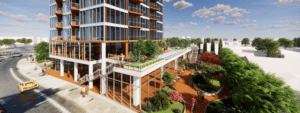Update: Great News! City of San Mateo voters said YES to Measure T to repeal an existing ordinance— enacted by voters since 1991—that limits height and density of new buildings. Passing with 59% of the vote, this measure will allow the City of San Mateo to make modest changes to the city’s General Plan that will facilitate badly needed new housing construction and help alleviate the city’s severe supply shortage.
Why It Matters
Since 1991, new infill housing development in the City of San Mateo has been severely constrained by a local voter initiative (known as Measure Y) that limits the height and density of new buildings. The result is a city that has become less affordable to working people, pushing both low and middle income residents and the city’s workforce to live farther away from where they work, leading to higher commute times and GHG emissions and furthers the expansion of exurban sprawl.
Over the past six years, San Mateo has been working diligently to craft a significant update to the City’s General Plan—the first one in decades. That process has included input from a wide range of stakeholders and extensive outreach to the community, with hundreds of meetings held and myriad chances for residents to weigh in and make their voices heard. During the process, local leaders ultimately settled on a series of zoning changes in key areas across the city, including downtown, around the city’s three Caltrain stations, along El Camino Real, and elsewhere. These changes will increase new housing development to both promote affordability, and, critically, to comply with state housing laws.
Because infill housing is so expensive to build, developers need much greater densities than what is currently allowed in San Mateo in order to make new housing financially feasible to create. By artificially limiting how much housing you can build on a single plot of land to just five stories and 50 units per acre, as San Mateo currently does, the city makes it extremely costly, and in fact virtually impossible in many cases, for new housing to be built. The outcome of this policy choice is that San Mateo suffers from a significant shortage of housing, which has led to overcrowding, displacement of low-income residents, and a city that is increasingly affordable only to the most affluent.
San Mateo’s current zoning is inherently exclusionary and unsustainable. By severely limiting the amount of new housing—particularly affordable housing—that can be built within the city, San Mateo is pricing out its low-income residents, forcing workers into super commutes, and furthering harmful development patterns of exurban sprawl across the rest of the region and state.
Measure T is a step in the right direction to start to lift these constraints and reverse this trend and we are delighted that voters made their voices heard on the matter.
Originally published on September 23, 2024.





